

| (1) |
Ex: Estimate the energy gain per turn due to this betatron effect in a small rapid-cycling synchrotron: frep=60 Hz, B in the dipoles varying from 0 to 2 Tesla, 200 m orbit length, half-filled with dipoles, each having a field occupying 20 cm. (Answer: a few kV.) Does it make any difference if C-magnet dipoles have their yokes inside or outside the beam orbit? The highest energy betatron is 300 MeV. Why are higher energies impractical?In the remainder of this note, I deal with the effect of the rf gap on beam particles, the effect of the lattice on how beam particles move with respect to each other, and finally a description of the longitudinal dynamics resulting from the combination of these effects. The main emphasis will be on proton synchrotrons, but the discussion will be generalized wherever possible.

| (2) |
| (3) |
| (4) |
| (5) |
| (6) |
| (7) |
| (8) |
| (9) |
| (10) |
Ex: For a circular gap, find the rf magnetic field and show that the contribution it makes via [F\vec]=e[v\vec]×[B\vec] to dx¢ is -b2 times the electric contribution. This changes the total contribution by the factor 1-b2=1/g2.For a circular gap as is generally the case in linacs and synchrotrons, fx=fy=f so we have
| (11) |
| (12) |
Ex: The following accelerators are all proton machines i.e. mc2=938/,MeV. (1) In a typical proton synchrotron, w =2p×50 MHz, V=100 kV (per cavity), kinetic energy, T=600 MeV at injection so b =0.79 and g =1.64. This gives f=39 km: not an important effect. (2) In the LAMPF drift tube linac at injection, rf frequency is 200 MHz, V is around 1 MV, and T=750 keV at injection. This gives f=3 cm: clearly an important effect. (3) In the TRIUMF cyclotron, injection is at 300 keV, V=200 keV, and the rf frequency is 23 MHz. This gives f=15 cm, and since there is little magnetic focusing near injection (the machine centre), this is a large effect. As a matter of fact, the rf (de)focusing prohibits operating with f less than 90°.Generally, the transverse rf focusing is important in cyclotrons and in proton linacs. In electron linacs, g is usually so high that the gap focusing is not important. For a net focusing effect, we want 1/f to be negative. This requires f to be between 90° and 270°. Recall that this arises because the focusing is related to the time derivative of the electric field. Hence the central ingredient for net transverse rf focusing is a falling electric field2.
| (13) |
| (14) |
| (15) |
Ex: We go through the same three examples. (1) In a typical proton synchrotron, w =2p×50 MHz, g=4 cm, and at T=600 MeV v=0.8c, giving q = 0.05 and Tt=0.99989: a small effect. (2) In a drift tube linac we can think of setting the drift tube length approximately equal to the gap g. This automatically means q = p, and Tt=0.6. In this case it is clearly advantageous to make the gap as small as possible (up to the sparking limit). (3) In cyclotrons, q is simply the angle subtended by the rf gap, multiplied by h, the harmonic number, i.e. the number of times the rf electric field oscillates during one revolution of the particle (more about this quantity later). In the case of TRIUMF, h=5. In order to keep Tt near 1, the gap is narrower at the centre of the machine than elsewhere. This is shown in the following sketch.

| (16) |
Ex: Find 1/fz directly without using the above result, but by finding the difference between Dp/p for an arbitrary particle and for the synchronous particle.
| (17) |
| (18) |
| (19) |
| (20) |
Ex: The isochronism condition is more simply v/r=constant. Use this to prove B=gB0, where B0 is a constant.In synchrotrons (and synchro-cyclotrons), wrf is varied with time to stay in step with the accelerating beam. Therefore there is no isochronism constraint. Generally, dipoles (usually flat, but not necessarily) are interspersed with quadrupoles so that the off-momentum particle follows some convoluted orbit.

| (21) |
| Accelerator | momentum | phase slip |
| type | comp. ac | h |
| Proton linac | 0 | -1/g2 |
| Electron linac | 0 | 0 |
| Cyclotron | 1/g2 | 0 |
| Synchrotron | fixed by lattice | ac-1/g2 |
| (22) |
| (23) |
| (24) |
| (25) |
| (26) |
| (27) |

Ex: Fermilab Booster; h=84, gt =5.4 i.e. ac =0.034. At injection, T=200 MeV, V=275 keV, fs =0 (just before acceleration starts), and the rf frequency is 30 MHz. Find the phase oscillation frequency ff=wf/(2p). At extraction, just as acceleration ends, T=8 GeV, the rf frequency is 53 MHz and V=380 kV. What is fs? Find frf and ff. Also find the `synchrotron tune' ff/frf in both cases.
| (28) |
Ex: In the Fermilab Booster, say we want to drop V by 100 kV at extraction. How quickly can this be done? In the SSC LEB, matching the beam to the MEB requires dropping the rf voltage a factor of 10 in the last millisecond. But at extraction ff is very low, around 500 Hz, because h is very small. Will the motion be adiabatic during this change?
| (29) |
| (30) |
| (31) |
| (32) |
| (33) |
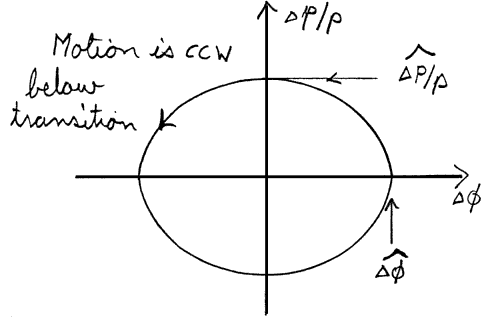
| (34) |
Ex: Generally, the longitudinal emittance is given in energy-time units as ef =p[^(DE)][^(Dt)]. The conversion from one system of units to the other is left as an exercise to the reader. Ans:So from eqn. 34 it is not wf, but wf/h whose slowness of variation determines the adiabaticity. This means that transition crossing is not necessarily non-adiabatic. For adiabaticity, we would like the quantity [(Vcosfs)/(2ph(-h)b2gE0)] to be constant near transition, but at the same time, the magnets continue ramping up and so the energy gain dE =Vsinfs is a given constant as well. Together, these determine both V and fs as a function of time through transition:
ef= b2gE0 wrfæ
ç
èp
Dp pö
÷
ø(35)
| (36) |
| (37) |
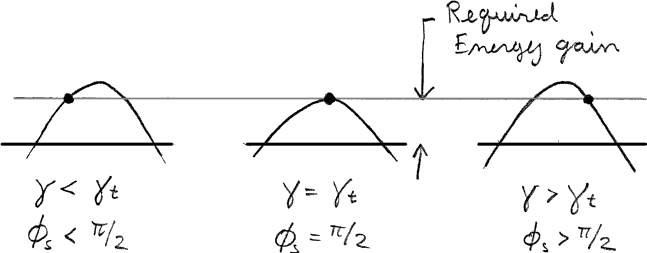




| (38) |
|
| (41) |
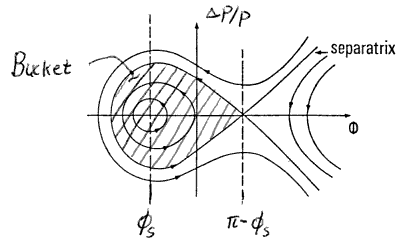
| (42) |
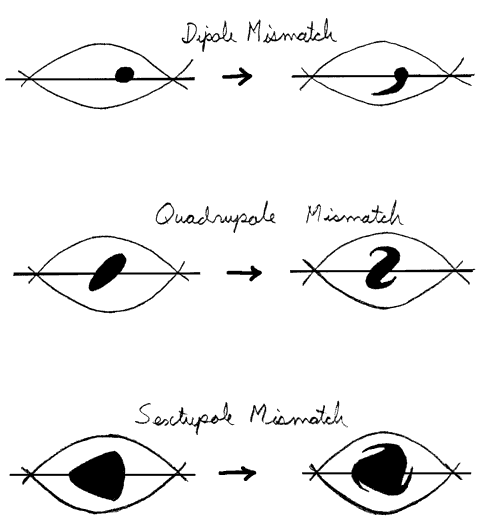
Ex: At injection, the TRIUMF Booster (proposed in 1989 but never built) has fs =0, [^(Df)]=100°, and wf =2p×50 kHz. Calculate the time interval over which mismatch errors must be damped. Ans: Must be short compared with 17 ms, i.e. a few turns (each turn is 1 ms).
| (43) |
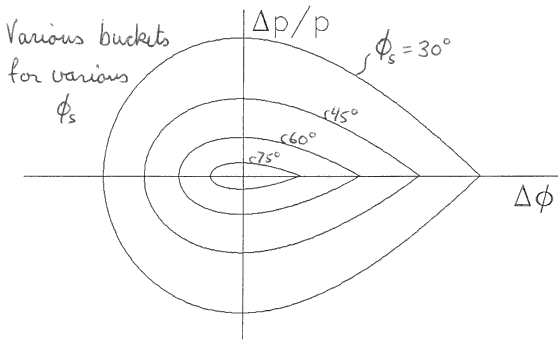
| (44) |
|
| (46) |
Ex: Calculate the voltage V needed in the SSC Low Energy Ring (never built) at injection (600 MeV, fs =0) to accommodate ef =0.018 eVs with a filling factor of Pf=75 %. Other parameters are frf =50 MHz, h=114, and gt is very high (ac << 1/g2). Ans: 155 kV.Notice that V µ 1/Pf4, so increasing the safety margin costs a lot in rf. Eg., decreasing Pf by 20% requires a twice larger rf voltage. Given dE =Vsinfs, we can cast the last eqn. into the following slightly simpler form, useful for moving buckets (i.e. fs ¹ 0):
| (47) |
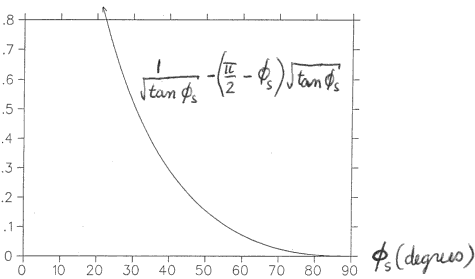
Ex: At mid-cycle in the SSC LEB, T=(g-1)E0=5.73 GeV, dE =0.611 MeV (comes from a total energy gain of 10.5 GeV in a sinusoidal acceleration ramp of 50 ms). For ef =0.02 eVs and Pf < 0.5, find the upper limit on fs and the lower limit on V. Ans: 52° and 770 kV.
| (48) |
| (49) |
| (50) |
| (51) |
| (52) |
| (53) |
| (54) |
| (55) |
| (56) |
| (57) |
|
| (59) |
| (60) |
|
| (63) |
| (64) |